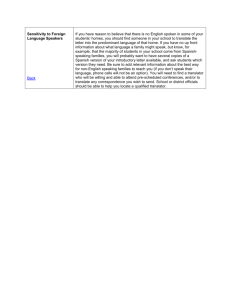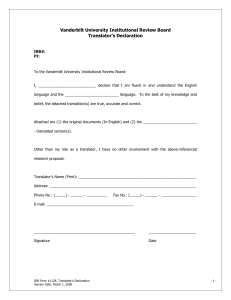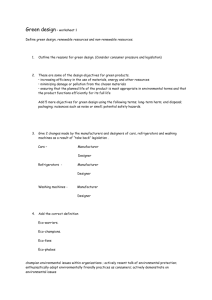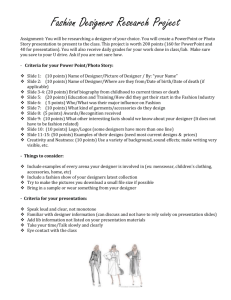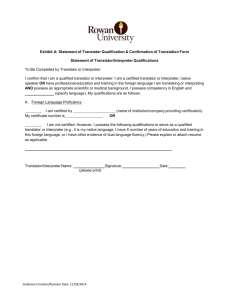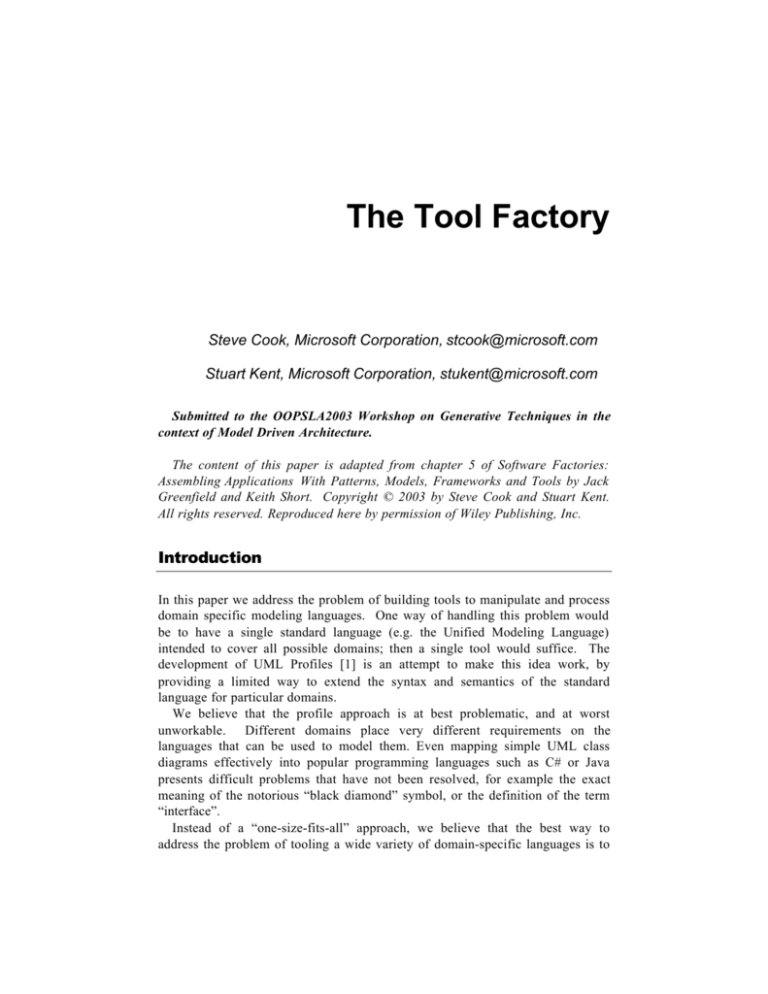
The Tool Factory
Steve Cook, Microsoft Corporation, stcook@microsoft.com
Stuart Kent, Microsoft Corporation, stukent@microsoft.com
Submitted to the OOPSLA2003 Workshop on Generative Techniques in the
context of Model Driven Architecture.
The content of this paper is adapted from chapter 5 of Software Factories:
Assembling Applications With Patterns, Models, Frameworks and Tools by Jack
Greenfield and Keith Short. Copyright © 2003 by Steve Cook and Stuart Kent.
All rights reserved. Reproduced here by permission of Wiley Publishing, Inc.
Introduction
In this paper we address the problem of building tools to manipulate and process
domain specific modeling languages. One way of handling this problem would
be to have a single standard language (e.g. the Unified Modeling Language)
intended to cover all possible domains; then a single tool would suffice. The
development of UML Profiles [1] is an attempt to make this idea work, by
providing a limited way to extend the syntax and semantics of the standard
language for particular domains.
We believe that the profile approach is at best problematic, and at worst
unworkable. Different domains place very different requirements on the
languages that can be used to model them. Even mapping simple UML class
diagrams effectively into popular programming languages such as C# or Java
presents difficult problems that have not been resolved, for example the exact
meaning of the notorious “black diamond” symbol, or the definition of the term
“interface”.
Instead of a “one-size-fits-all” approach, we believe that the best way to
address the problem of tooling a wide variety of domain-specific languages is to
be able rapidly and economically to specify new languages, and to provide
automated support for building tools that implement these languages. We can
exploit similarities in languages within a language family to simplify the
generation of tools that manipulate members of that family. See [2] for some
techniques to define language components that can be combined to create
language families.
A tool factory is a software system used to build tools that manipulate and
process the members of a family of domain specific languages from
specifications of the family members. In what follows we describe the
architecture of a tool factory.
Tool Factory Architecture
Figure 1 gives a bird’s eye view of the architecture of a tool factory for a family
of domain specific languages, F. In the diagram, ovals represent tools, rectangles
with folded corners represent artifacts, solid arrows represent derivation and
dashed arrows represent generation. The Language Designer is a tool for
designing family members. The diagram shows a design for some language, X,
created in the Language Designer. The design of X includes all of the following
pieces:
•
•
•
•
concrete syntax – a specification of how the language is physically
presented to and manipulated by its users, in graphics and text
abstract syntax – a specification of the concepts of the language and
how they are inter-related
serialization syntax – a specification of how expressions in the
language may be serialized in a textual form for interchange between
tools (typically but not necessarily using XML), and
semantics – a specification of the meaning of expressions in X,
expressed in terms of well-formed traces based on a trace language
for X.
The design of X is created in the Language Designer from language fragment,
Y, and language design pattern, Z, defined for the language family, F. Language
designs created in the Language Designer are fed into a Design Tool Generator,
which generates part of a design tool for X. We use the term designer to mean a
design tool, and the term X-designer to mean a design tool for the language
named X.
Y : Language
Fragment
Language Designer
Z : Language
Design Pattern
X : Language
Design
Design Tool Generator
X Designer
Figure 1 Overview architecture of a tool factory
Figure 2 gives one perspective on the architecture of an X-designer, in terms of
functional components. At the heart of the architecture is an In-Memory Store
(IMS), which stores both the Abstract Syntax Graph (ASG) and layout
information for designs and traces of the language X. The format of the
information is dictated by the definition of X and its trace language. The IMS
also stores a definition of X itself, which can be read by code that needs to
interpret the language.
The rest of the components work off the IMS. The Design Surface lets the user
manipulate expressions and traces of X through their respective graphical and
textual concrete syntaxes. It interacts with ASGs and layout information stored in
the IMS, and manages graphical layout, as well as the display and parsing of text
embedded in diagrams. The Serializer serializes ASGs and layout information
from the IMS using the serialization syntaxes.
The Rule Checker checks well-formedness rules over information stored in the
IMS. Static code could be generated from rules language expressions, but a more
powerful alternative is to enable the Rule Checker to interpret the rules language
expressions dynamically. This lets the language designer experiment with rules
before fixing them in the language definition. It also lets the language user build
queries that retrieve information from models, and filters that control the display
of models. Interpretation also makes the pattern engine, and external tools, such
as the translators shown on the diagram, more powerful and easier to build.
The Pattern Engine is a language independent component that implements
pattern-based model mapping techniques. It uses the IMS, the design surface and
language specific extensions, to provide those automations. A critical component
of the Pattern Engine is a Merge Engine, which merges the results of pattern
evaluations with each other, and with the existing elements in the target models.
The Pattern Engine can also store pattern applications in the IMS, so that they
can be edited and reevaluated when the values of their arguments change.
Models can be animated or interpreted, and used to trace execution. The
Animator/Interpreter and Model by Example components implement these
automations using the trace-based semantics for X.
•
The Animator/Interpreter implements the mapping from models to
traces to provide either an interpreter, for an imperative language, or
an animator, for a declarative language. An animator asks the user to
decide any non-deterministic choices that it can not resolve, while an
interpreter always makes a choice.
•
Model by Example implements the mapping in the opposite direction.
It can automatically construct a partial model from example traces
developed by the user (e.g. to illustrate particular problem scenarios)
or recorded by an execution tracing tool.
The XY Translator and XY Trace Translator are examples of tools that interact
with designers. If Y is a general purpose programming language, then the XY
Translator might generate Y based code from X based models. However, if X is a
business processes modeling language, and Y is a software architecture modeling
language, the XY Translator might reconcile X and Y based models manipulated
independently and concurrently by different users. In either case, the XY
Translator would interact with the designers, but would not be embedded in
them.
The XY Trace Translator might be used, for example, to monitor execution
traces generated by an X based system, and to display them through X based
models. If X is a declarative language, then the XY Trace Translator might also
be used for testing, by checking the traces against the X based models, to see if
they satisfy them. If X is a business process modeling language, then the XY
Trace Translator might also be used to generate a dashboard, where traces of the
running business processes could be tracked.
X Designer
Patterns Engine
WF Rule checker
ASG
layout
Y traces
X designs
X tr ace s
Design
Surface
X design s
In-Memory Store (IMS)
Y traces
X traces
Animator /
Interpreter
Model by
Example
design of X
Serializer
X Y Translator
Y designs
Y designs
X Y Trace
Translator
Y traces
Y traces
Figure 2 The Detailed Architecture Of A Designer
Figure 3 gives another perspective of the makeup of the X-designer. While our
long-term vision is to generate complete designers from language definitions, this
will certainly not happen soon, so we expect some hand-coding to take place.
Code generation works best when the generated code completes an existing
framework. Of course, there is a trade-off between placing functionality in the
generated code, and placing it in the framework. In practice, a combination of the
two approaches usually works best.
X Designer
Generated code
Hand-crafted
code
X Language
Definition
Designer Code Framework
interpret
Figure 3 Where The Code Comes From
The Language Designer is just another X-designer, where X is the language for
designing languages (LDL). Hence, it should have the same architecture as other
designers, as illustrated in Figure 4. In particular, it is worth noting that in this
case the pattern engine can be used to support the definition of language families.
Figure 4 provides the last twist in the tale, observing that it should be possible to
generate the LDL-designer from a definition of the language for designing
languages (LDL). This allows the tool factory to bootstrap itself from one version
to the next. In addition, provided the LDL is rich enough, it should be possible to
define a mapping from language designs into the programming languages and
frameworks used to implement designers, allowing the design tool generator to
be bootstrapped, as well.
Language Designer
X : Language
Design
LDL : Language
Design
Design Tool Generator
X Designer
Figure 4 The Bootstrap
References
[1] S. Cook. The UML Family: Profiles, Prefaces and Packages. Proceedings of
UML2000, edited by A. Evans, S. Kent and B. Selic. 2000, Springer-Verlag
LNCS.
[2] A. Clark, A. Evans and S. Kent. A Metamodel for Package Extension with
Renaming. In J.-M. Jézéquel, H. Hussmann, S. Cook (Eds.): UML 2002 The Unified Modeling Language 5th International Conference, Dresden,
Germany, September 30 - October 4, 2002. Proceedings LNCS 2460, 305320, 2002.
Possible Contribution to Workshop
Before joining Microsoft earlier this year, both Steve and Stuart were closely
involved in the definition of the UML 2 standard, and published several papers
about model driven approaches to software development. We have views about
all of the topics of interest of the workshop. We could readily present in-depth
material on any of the following topics:
• The tool factory (content of this paper)
• Problems with UML as a basis for MDA
• Approaches to pattern-driven model transformation



